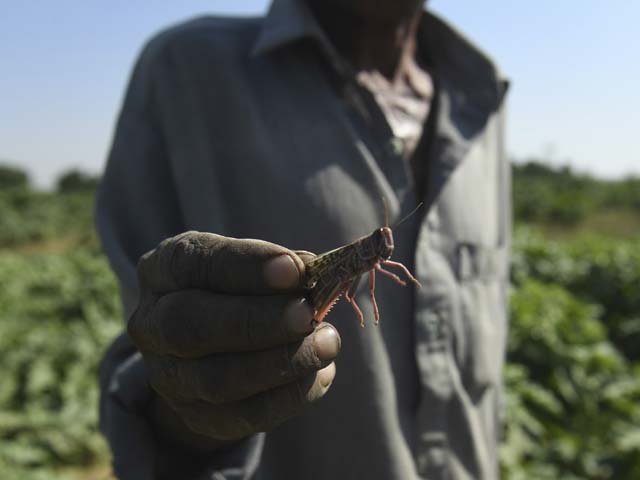
The link between Pakistan’s locust crisis and climate change
Crawling across thousands of kilometres (km) and flying through the air, millions of locusts have swarmed large swathes of agricultural land in Pakistan and India, devouring any vegetation in their path. The United Nations’ Food and Agriculture Organisation (FAO) says that Pakistan will lose more than USD four billion worth of rabi and kharif crops. According to the FAO, 38% of the land area of Pakistan (60% in Balochistan, 25% in Sindh and 15% in Punjab) is a breeding ground for desert locusts. They move in swarms of up to 50 million locusts, and each swarm can travel up to 150 km a day, eating as much food as consumed by 35,000 people, and laying 1000 eggs per square metre. The situation can easily turn dire if these swarms are not contained, and if they migrate to other areas of Pakistan.
The daily lives of farmers have changed dramatically with locust attacks affecting more than 60 districts across Pakistan. Farmers resort to traditional remedies such as banging utensils and watching crops from dusk till dawn, in a vain attempt to dispel desert locusts from their farms. To their dismay, locusts by the millions are paving their way towards Pakistan from the Horn of Africa.
While locust plagues are not new, scientists say climate change is making them worse. It is argued this infestation is driven by unusually warm weather and heavy rains in the Arabian Peninsula, creating the ideal breeding ground. From mid-2018 to early 2019, the Empty Quarter along the borders of Oman, Yemen and Saudi Arabia witnessed two large cyclones that brought heavy rains, resulting in an 8000-fold increase in locust numbers in remote areas, where survey and control activities could not be conducted. By January of 2019 a new generation of swarms had bred, which then migrated to the Horn of Africa and the Indo-Pakistan border during the summer of 2019.
In normal conditions, desert locusts usually undergo quiet periods in semi-arid and arid desert regions of South-West Asia, Near East and Africa, which receive less than 200 millimetres of rain annually. These locusts either migrate from these regions or die of natural mortality. But the last five years have been hotter than any other since the industrial revolution. Research links hotter climate to more intense and damaging locust swarms, leaving Africa and South-West Asia disproportionately affected. Keith Cressman, a senior locust forecasting officer with the FAO, says that locust breeding is directly linked to soil moisture and food availability. Therefore, rain patterns have a strong influence on locust populations.
Climate change also led to wet weather (ideal for locust breeding) in the Horn of Africa caused due to 400% above-average rainfall from October-December 2019. These abnormal amounts of rainfall were a result of the Indian Ocean Dipole (IOD), a phenomena accentuated by climate change. Scientists have warned that the IOD can become a regular occurring phenomenon in more extreme forms, as sea temperature rises. For these reasons, the locust attacks in Pakistan cannot be viewed in isolation. Rather, they are a part of the wider global climate changes aggravated by global warming.
According to the FAO locust watch (May 27, 2020), adults are forming groups and small swarms in spring breeding areas in the southwest (Balochistan) and the Indus Valley (Punjab). These infestations will move to the summer breeding areas along the Indo-Pak border, from Cholistan to Tharparkar. In response to the locust plague, Pakistan has declared a national locust emergency with a comprehensive National Action Plan for Surveillance and Control of Desert Locust in Pakistan, 2020-2, consisting of three phases. The effort to coordinate and support large-scale locust control operations is being spearheaded by the Federal Ministry of Food Security and Research in collaboration with National Disaster Management Authority (NDMA), provincial agriculture departments, and the armed forces.
Among the initiatives to safeguard national food security are efficient coordination with key stakeholders (public and private sector institutions), timely resource mobilisation, effective surveillance, control operations, and mass awareness activities as per the Standard Operating Procedures (SOPs) endorsed by the FAO to combat serious threats to agriculture from desert locusts. For a timely and effective response, Pakistan is collaborating with Iran and India under the FAO Commission for Controlling the Desert Locust in South-West Asia (SWAC). It has also sought help from China and the United Kingdom, with the Department for International Development (DFID) of the United Kingdom pledging £6 million for locust control in Pakistan. However, these measures are slow and delayed, with many farmers left to fend for themselves in trying times amidst Covid-19.
While the government mulls over the various possibilities to address the locust crisis, it is imperative to include the factor of climate change. To save Pakistan, and the region, from repeated episodes of locust invasions it is the need of the hour that a joint regional climate strategy be devised. Perhaps, the SWAC can be expanded to promote climate change dialogue between Pakistan, India, Iran and Afghanistan. Without further delay, concrete action is required because the storm is brewing.




COMMENTS
Comments are moderated and generally will be posted if they are on-topic and not abusive.
For more information, please see our Comments FAQ